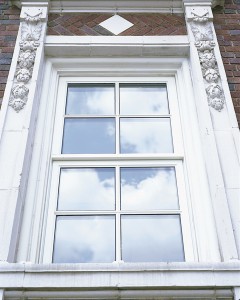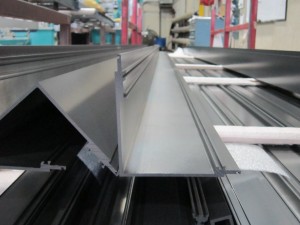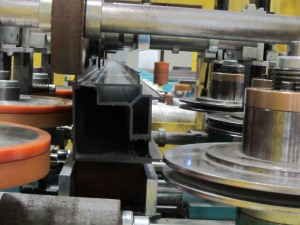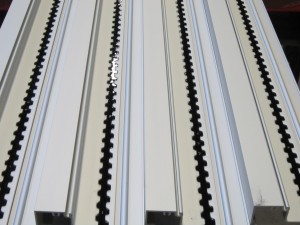Client News: Linetec announces new thermal improvement offerings
Contributing to commercial and residential properties’ energy efficiency goals, Linetec has expanded its services to further enhance the thermal performance of architectural metal products, such as window, skylight, curtainwall, storefront and entrance systems. Linetec’s new offerings include: lancing for improved adhesion to complement polyurethane poured-and-debridged thermal barrier systems, polyamide insulating strip (thermal strip) with widths up to 50mm for increased thermal efficiency and complete installation capability of 90-degree thermal strip with greater efficiency, quality and consistency. 
“Linetec continually invests in industry-leading innovation to support our customers. Meeting the demand for greater energy efficiency, architectural product manufacturers are responding with systems that deliver higher thermal performance,” says Linetec’s vice president of operations, Andy Joswiak. “Linetec is perhaps the only company in North America with this comprehensive capability and the industry expertise to offer of high-quality finishing and thermal improvement services.”
Joswiak continues, “Aluminum is the material of choice for many architectural product manufacturers, especially AW-rated window, door and curtainwall products for commercial applications. However, aluminum is a highly thermal conductive material that will rapidly transfer thermal energy. Linetec has the thermal performance solutions to minimize thermal energy transfer in aluminum systems.”
A thermal barrier system improves performance by separating the aluminum profile into two parts, while maintaining the structural and long-term durability of the unit. The two methods for doing this are pour-and-debridge systems or thermal strip. Thermal comfort and energy performance, along with daylight, views and indoor environmental quality, are recognized by such green building and design guidelines as the U.S. Green Building System’s LEED® certification.
Thermal Strip: 90-degree and Wider Material
 “Linetec is one of very few companies in North America to provide 90-degree thermal strip with a single pass using Technoform Bautec’s polyamide insulating strips and Müller Technologies AG’s knurling equipment to install the strip simultaneously on two planes of material,” explains Bart Hensley, sales engineer at Technoform Bautec.
“Linetec is one of very few companies in North America to provide 90-degree thermal strip with a single pass using Technoform Bautec’s polyamide insulating strips and Müller Technologies AG’s knurling equipment to install the strip simultaneously on two planes of material,” explains Bart Hensley, sales engineer at Technoform Bautec.
“The need for direct access from both sides has always been a design limitation of strip systems. This new capability frees up window and curtainwall designers to detail changes in place more efficiently, using a single assembly, rather than multiple pieces – without compromising energy efficiency or condensation resistance,” says Steve Fronek, P.E., LEED Green Associate, who serves as vice president of technical services at Wausau Window and Wall Systems. Wausau relies on Linetec for all of its finishing and thermal improvement services.
When installing thermal strip, Linetec follows the requirements of AAMA QAG-2-12, “Voluntary Quality Assurance Processing Guide for Polyamide Thermal Barriers.” First, the inside and outside aluminum profiles are finished in anodize, liquid paint or powder coating. Different colors and finishes may be used on each profile as the aluminum is extruded independently with a cavity that will receive the strip.
 During the assembly process, knurling produces “teeth” in the aluminum pocket that “bite” into the strip and ensures appropriate shear strength of the composite profile. As material passes through the knurler, the strip is inserted into the extrusion cavity. The crimping process mechanically locks the aluminum and strip, forming the bond between the two extrusions and the strip.
During the assembly process, knurling produces “teeth” in the aluminum pocket that “bite” into the strip and ensures appropriate shear strength of the composite profile. As material passes through the knurler, the strip is inserted into the extrusion cavity. The crimping process mechanically locks the aluminum and strip, forming the bond between the two extrusions and the strip.
“Traditional 90-degree thermal strip installation was time-consuming where each piece is knurled up to three times before crimping and shear testing. This amount of handling increases the potential for marring and damage to the finished material,” cautions Hensley. “Linetec’s 90-degree thermal strip process reduces the knurling to one step. This not only saves time and labor, but also minimizes inconsistencies and waste, holds customer-specified tolerances for U-Factor and shear testing, and delivers a high-quality finished product.”
Technoform Bautec now supplies Linetec with polyamide insulating strips ranging from 10mm to 77mm widths. Hensley adds, “Strip offers increased energy savings with varying thermal separation widths. Greater widths mean greater separation between the aluminum profiles, which means better thermal performance.”
Pour-and-Debridge: Lancer
 Enhancing its pour-and-debridge thermal improvement services, Linetec has added an Azon Lancer™ to provide mechanical surface conditioning of the aluminum extrusion cavity to ensure maximum adhesion of the thermal barrier polymer to durable, architectural finishes.
Enhancing its pour-and-debridge thermal improvement services, Linetec has added an Azon Lancer™ to provide mechanical surface conditioning of the aluminum extrusion cavity to ensure maximum adhesion of the thermal barrier polymer to durable, architectural finishes.
Pour-and-debridge thermal barrier systems use a two-part polyurethane that is poured into and cured within a “dog bone” structural cavity in the finished aluminum extrusion. The channel’s surface is conditioned using the Lancer to pierce the surface creating lanced, inward curving aluminum lug projections in a staggered formation along the extrusion cavity. This  mechanically locks the polyurethane polymer with the finished surface of the aluminum profile to ensure significantly improved adhesion. After the polyurethane has been poured into the cavity and solidified, the metal bridge from the bottom of the channel is removed to produce a true, non metal-to-metal structural thermal barrier.
mechanically locks the polyurethane polymer with the finished surface of the aluminum profile to ensure significantly improved adhesion. After the polyurethane has been poured into the cavity and solidified, the metal bridge from the bottom of the channel is removed to produce a true, non metal-to-metal structural thermal barrier.
As an approved Azo-Brader and Lancer Applicator, Linetec follows the guidelines set forth in the Azon “Quality Assurance Guide” and AAMA QAG-1-09, “Quality Assurance Processing Guide for Pour and Debridged Polyurethane Thermal Barriers.” Aluminum extrusions that receive mechanical surface conditioning from Linetec using either the Azo-Brader or the Lancer are supported with a 10-year warranty.
###
Filed under: AAMA, CLIENT NEWS, Green Goals, Linetec, Products, Technoform Glass Insulation, USGBC, Wausau Window and Wall Systems